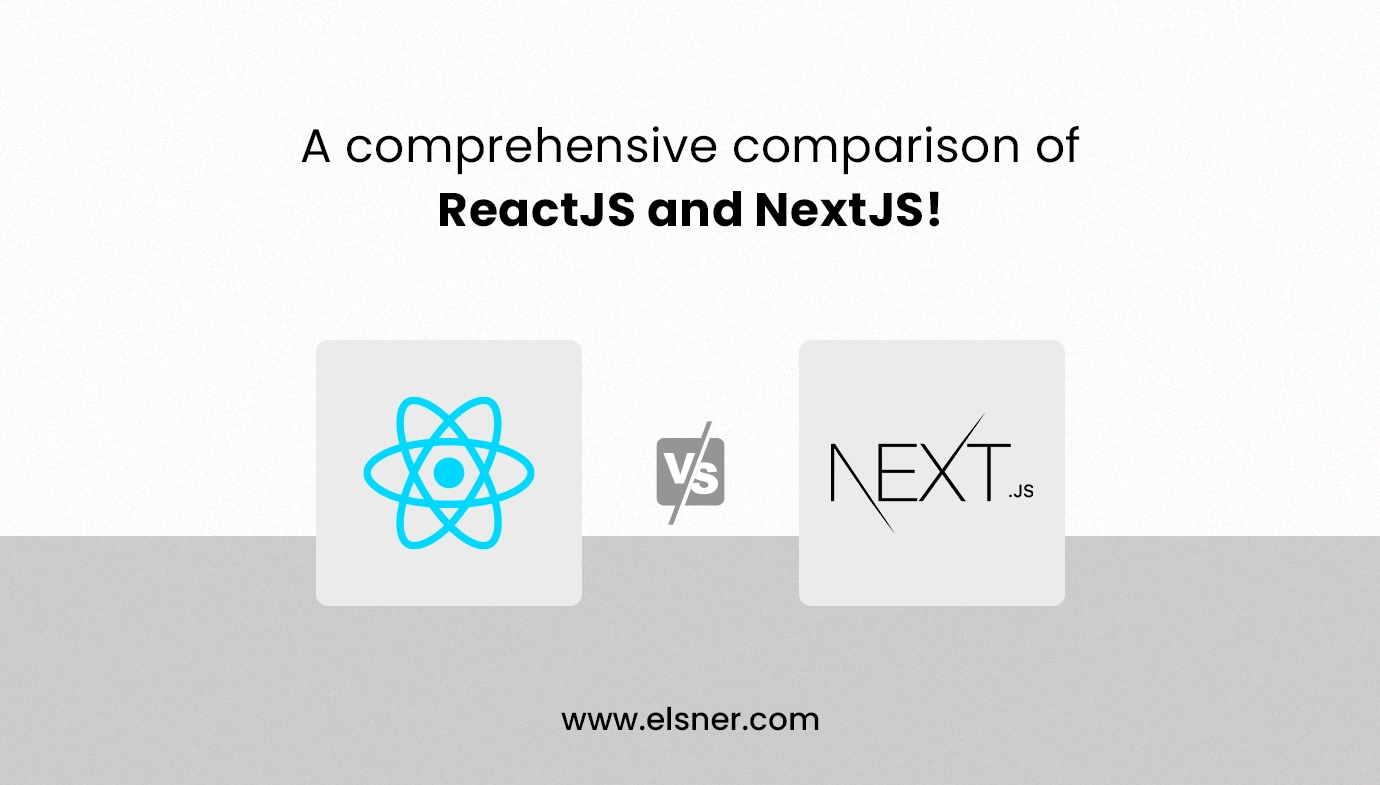As far as web development aspects are concerned, it is common for all developers to seek a comparison between ReactJS and NextJS. Both are brilliant front-end frameworks for you to get along with to ensure your business success.
Even though NextJS is built on top of the ReactJ S development framework, there are still some variations that put the business owners in a dilemma to choose between the two. Both React as well as NextJS have the capabilities to deliver outstanding UI for your web development project, but they have certain differences.
You ought to know these differences in order to decide on which framework would suit your needs better, giving you a responsive and high-performance solution. In this article, you will be diving deeper into the detailed efficacies of ReactJS development and NextJS and will gain insight into the unique benefits, features, and major considerations.
So, read this article till the end to get a comprehensive understanding of both of these frameworks and make an informed decision.
What is the Significance of ReactJS?
React is one of the most reputed JS libraries, which was developed by Facebook. You get an immensely powerful and efficient way to build UIs for your web apps. Among the several reasons behind the popularity of ReactJS, the most considerable one is its component-based architecture.
With this approach, the developers are allowed to build modular and reusable components, making the code maintenance and organisation an absolute breeze. In accordance with that, ReactJS makes use of the virtual DOM for efficiently updating or rendering the UI element, which will result in creating better performance and smooth UX.
The working approach of React is in a way such that it divides all the complex Ui elements into smaller components. As per the default feature, the purpose of React is to dynamically render all the components within the client-side React DOM. For every DOM, ReactJS builds a virtual DOM, which is a lightweight copy for enhancing the manipulation speed.
React is an immensely easy-to-learn framework and is popular among all front-end developers, as it offers the scope of customizability, even while dealing with tricky UIs. If you are running a business that involves the need to manage bulk customer data, hiring ReactJS developers is the best decision you will make.
Some of the key features of ReactJS that you must take note of are:
- React JS development provides you with the feasibility of creating reusable and modular UI components. Thus, building complex UIs with the use of React is quite easier when compared to other frameworks.
- ReactJS comes with Virtual DOM, which updates efficiently only on the necessary UI parts, which will improve the performance.
- React comes with a vast ecosystem of libraries, community support, and tools, which will make it a suitable framework to address various use cases.
- With React, a one-way data flow is attained, which makes it easier for the ReactJS developers to track the changes and hold onto the application state.
Within the ReactJS ecosystem, you will find this framework to be constantly growing with its offerings of various third-party tools, community support, and libraries. The developers will be able to find solutions for diverse requirements, starting from state management to global state management.
With the availability of diverse resources, tutorials, forums, and other such materials, it is clear that mastering ReactJS is immensely rewarding and accessible.
What is the Significance of NextJS?
NextJS is the open-source front-end development framework, which is designed to work feasibly alongside React JS development projects. But even by itself, it is a noteworthy framework for building SSR (Server-Side Rendering), apps, landing pages, eCommerce stores, or Websites with SEO-friendliness ensured.
NextJS has all the required tools for making the site faster! As NextJS is built on top of ReactJS, it helps the latter to overcome some of its technical limitations and helps create hybrid or static apps. Most of the renowned platforms such as Hulu, TikTok, Binance and others used it.
NextJS projects two different types of pre-rendering, the first is service-side while the other is static generation. With the service-side rendering, NextJS is enabled for fetching data and the render one request at a time. On the other hand, static generation is executed when the data is readily available before the request is made.
Therefore, NextJS becomes really useful in areas where the data is not publicly cached or is exactly user-specific. Following that, the NextJS also supports the typescript, which makes it one of the major reasons for its popularity. And that’s because typescript is a coding language that’s built over JavaScript.
Some of the features of NextJS are as follows:
- NextJS allows you to rent the ReactJS components on the respective server before you send them to the clients, resulting in improved SEO and faster loading speed.
- With NextJS, pre-rendering of the pages is supported at the build time, which will enable the static HTML file generation for better caching and improved performance.
- When you seek NextJS, you will be implementing file-based routing, which will eliminate the need for complex routing configurations.
- With NextJS, you are allowed to create serverless functions, referred to as API routes, which will enable you to develop the backend functionalities and features within the framework.
Such additions to the NextJS framework are what simplify the overall development process when you use this framework. It will reduce the need for additional configurations and libraries. NextJS shares various React JS development features, including virtual DOM and component-based development.
It combines with the React capabilities, which allows the developers to seek pre-rendering of the pages over the server and deliver HTML to their client. With this approach, you can expect enhanced SEO, better initial page load times, and improved UX.
What are the Differences Between ReactJS and NextJS?
To help you get better clarity on whether you should hire ReactJS developers or NextJS developers for your web development project, here are some of the differences between these frameworks for you to count on based on diverse factors:
1. Performance
As far as , they are faster due to the use of static destinations, followed by server-side rendering. Apart from that, there are various performance enhancement inclusions made alongside NextJS development, such as image optimization and others.
Due to this, when you pick NextJS for the project, you will be able to attain code-splitting and automated server rendering facilities. Thus, it will enhance the overall development performance. Beyond that, in the case of React JS development, the client-side rendering support of this framework might not be sufficient enough for developing high-performance apps.
2. Speed and Ease of Coding
When you tend to create pages for your React project, the developers will have to add a component to its router. But, when you create specific pages for the NextJS development project, you will be able to simply add a page to the respective Pages folder. Thus, it will make life easier as the developers will have to write fewer codes, which makes the project easy to track.
If you plan on starting with React, there is a CRA tool that helps ReactJS developers create single-page applications easily. With this tool, creating the front-end assembly will be easier, and that can be used with almost any server of your preference. CRA is a preferred tool that will save you the trouble of customising and setting up the development environment.
3. Features
NextJS benefits from React, which helps developers for creating single-page apps. With NextJS, you get server-side rendering, static export, pre-rendering, automatic build-size optimization, and other such features. With them all, you can expect to create a ready-to-use and functional application using NextJS.
ReactJS is quite extensible and can offer you features such as libraries such as Redux, state management and routing patterns, an enormous community, and a CRA tool. Even though ReactJS is minimalistic, it can still be customised for diverse projects. In terms of features, you must look out for your project requirements and make the ultimate choice.
4. Documentation
Documentation is one part that gets overlooked while comparing the frameworks. Even though the NextJS and ReactJS developers are proficient enough to offer you appealing landing pages and websites, there comes a need at times for additional resources such as tutorials, articles, books, and courses.
With good documentation, it will help you use the tools easily for diverse software projects. Referring to the resources, the developers will find it easy to pick the right libraries for the selected project. For you to know, there are amazing documentation options for both React as well as NextJS for developers to deliver the best web development outcomes for you.
Parting Words
It becomes very important for you to choose the ideal framework for your development project. Both NextJS, as well as ReactJS development approaches, are proficient in delivering optimal output. But you must still consider diverse factors to choose one among the two.
As you know, React offers you a very powerful library for building appealing UIs, while NextJS is meant to extend the React features such as server-side rendering along with simplified routing.
With a deep understanding of the features, use cases, and benefits of both of these frameworks, you will be able to come to an informed decision. This article narrowed down this comparison to help you in this quest.

About Author
Tarun Bansal - Technical Head
Tarun is a technology enthusiast with a flair for solving complex challenges. His technical expertise and deep knowledge of emerging trends have made him a go-to person for strategic tech initiatives. Passionate about innovation, Tarun continuously explores new ways to drive efficiency and performance in every project he undertakes.








